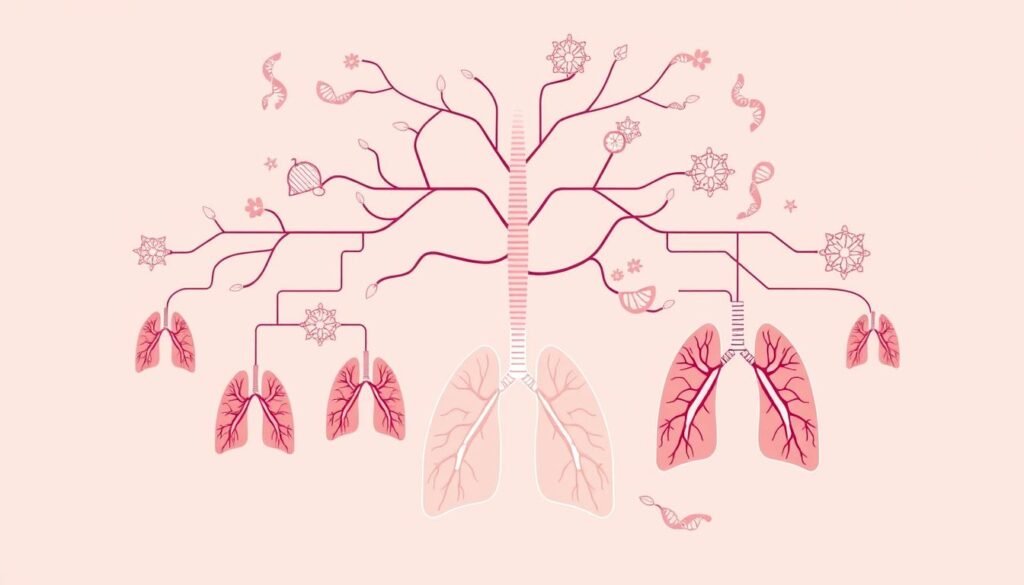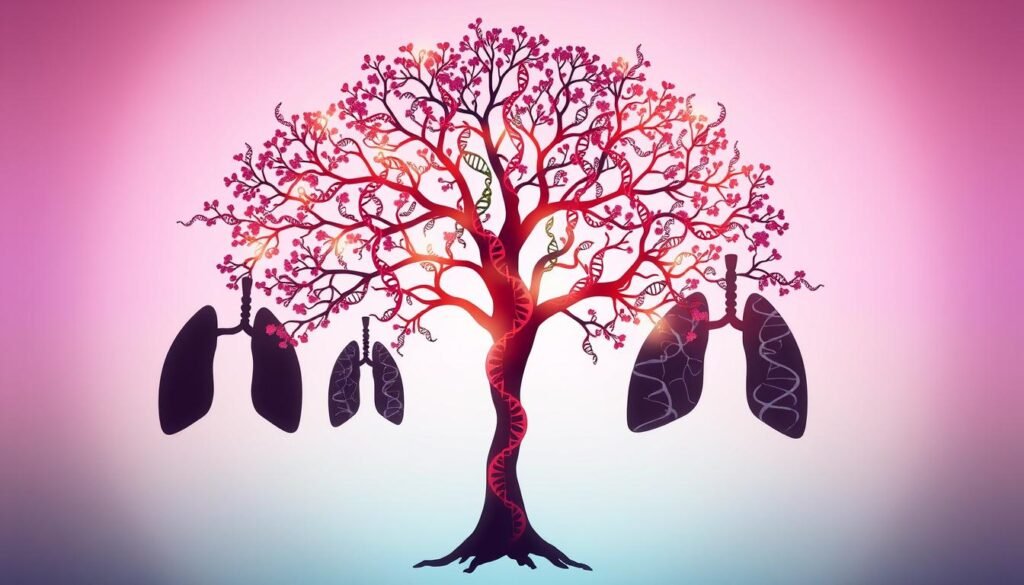Did you know having a close family member with lung cancer raises your risk by 1.51 times? This shows how genes and life habits both matter in cancer risks. Besides smoking and air pollution, knowing your family’s health history helps in preventing and spotting lung cancer early.
Lung cancer causes about 1.2 million deaths each year around the world. This makes it vital to understand both genetic risks and family trends. Studies have found that having a family history, especially a sibling with lung cancer, greatly increases your risk. This highlights the importance of knowing your family medical history to find those at higher risk.
As science uncovers more about how genes and environment contribute to lung cancer in families, it’s key to identify those at greatest risk early. For insights on squamous cell lung cancer, understanding these aspects helps in creating better treatment and care plans.
Key Takeaways
- Family history significantly elevates lung cancer risk, particularly in first-degree relatives.
- Individuals with a sibling diagnosed with lung cancer have the highest familial association.
- Understanding inherited cancer risk is crucial for early detection and prevention strategies.
- Effective cancer risk discussions with healthcare providers can guide assessment and action.
- Continued research will illuminate the interplay between genetics and environmental factors.
Understanding Lung Cancer: An Overview
Lung cancer starts from cells in the lungs and has different kinds. The two main kinds are small cell lung cancer (SCLC) and non-small cell lung cancer (NSCLC). NSCLC makes up about 80% of all lung cancer cases. This shows why knowing about lung cancer is key to looking into factors that might cause it.
About 1.8 million deaths were linked to lung cancer in 2020. This was 18% of all deaths from cancer worldwide. The number of cases differs greatly around the world. In men, higher rates are seen in places like Micronesia and Polynesia, and parts of Europe. For women, high rates are in North America and parts of Europe and Australia/New Zealand.
Lung cancer’s survival rate is low, mostly because it’s found too late. Smoking is a big cause, linked to about 85% of cases. Smokers are 22 times more likely to get lung cancer than non-smokers. Even if you quit, the risk is still higher than for those who never smoked, though it lowers over time.
A table summarizing various types of lung cancer and their characteristics is shown below:
| Type of Lung Cancer | Percentage of Cases | Characteristics |
|---|---|---|
| Non-Small Cell Lung Cancer (NSCLC) | 80% | Includes adenocarcinoma, squamous cell carcinoma, and large cell carcinoma. |
| Small Cell Lung Cancer (SCLC) | 20% | More aggressive, spreads rapidly, often diagnosed at advanced stages. |
Understanding lung cancer’s different types, important statistics, and risk factors is vital. Having easy-to-understand and correct info helps people make good choices. And it helps with talking about risks, treatments, and how to avoid lung cancer.
Genetic Factors in Lung Cancer Risk
Genetic risks have a big impact on lung cancer. Having family members with lung cancer can raise your risk. This is especially true if many relatives are affected. Lung cancer genetics research shows genes and lifestyle choices are linked. For instance, smoking is common in families with a history of lung cancer. This makes it hard to separate genetic and environmental factors.
About 5%–10% of lung cancers are due to inherited genes. It’s crucial to recognize these genetic risks. Lung cancer in families often comes from both genes and the environment. This means both factors increase disease risk.
Studying family patterns helps identify specific gene mutations. This can show a hereditary link. While smoking and pollution also affect lung cancer risk, exploring genetic risk factors is essential. It helps us fully understand how to assess risk for this disease.
Hereditary Cancer Syndromes and Lung Cancer
Some hereditary cancer syndromes can increase the risk of lung cancer. This is due to a genetic predisposition to the disease. For example, Li-Fraumeni syndrome, caused by TP53 gene mutations, makes people more likely to get various cancers, including lung cancer. This links inherited genes directly to cancer risk.
It’s key to know about these syndromes for early identification of high-risk individuals. Research shows that 5% to 10% of all cancers come from inherited mutations linked to these syndromes. Families with these conditions should be extra careful to lower their lung cancer risk.
The following table highlights some common hereditary cancer syndromes related to lung cancer:
| Hereditary Cancer Syndrome | Associated Genes | Increased Lung Cancer Risk |
|---|---|---|
| Li-Fraumeni Syndrome | TP53 | High |
| Familial Adenomatous Polyposis | APC | Moderate |
| Nevoid Basal Cell Carcinoma Syndrome | PTCH1 | Low |
| BRCA1/BRCA2 Mutation Syndromes | BRCA1, BRCA2 | Under Investigation |
Knowing about these syndromes helps people make better health choices. Early action and screening can greatly help those with a higher genetic risk of lung cancer.
How Family History Influences Lung Cancer Risk
Understanding the link between family medical history and lung cancer risk is key. If you have a first-degree relative with lung cancer, your own risk goes up significantly. This could double your chances of developing lung cancer. It’s not just about genetics; lifestyle and environment play roles too. This shows how complex lung cancer can be.
Impact of Family Medical History
Knowing your family’s medical history can tell a lot about your lung cancer risk. Studies show that people with lung cancer often have relatives with the disease. Up to 46.8% of patients might report such a family history. This information is crucial for early screening and taking preventive steps.
Relation between Family Structure and Disease Risk
Family structure matters a lot when it comes to lung cancer risk. People with many relatives who have cancer may face higher risks. There’s a link between family traits and genetic factors. This information helps doctors figure out how at risk someone is based on their family history.

| Family History Factor | Increased Lung Cancer Risk |
|---|---|
| First-degree relative with lung cancer | Twofold increase |
| Multiple affected family members | Even higher risk |
| Family history of any cancer | 8.3% to 68.9% |
| Family history of lung cancer | 2% to 46.8% |
Gene Mutations and Their Role in Lung Cancer
Gene mutations are key to our understanding of lung cancer. Certain mutations increase the risk of this illness. In particular, mutations in the genes TP53, EGFR, and KRAS are common among lung cancer patients. Knowing about these mutations helps identify who might be more likely to get lung cancer.
Common Mutations Associated with Lung Cancer
There are several gene mutations that are common in lung cancer. These mutations affect how we diagnose and treat the disease. We have listed some of the main mutations and their effects below:
| Gene Mutation | Associated Risk | Prevalence in Lung Cancer |
|---|---|---|
| TP53 | Increased tumor progression | Common in various lung cancer types |
| EGFR | Higher likelihood in adenocarcinoma | Approximately 10% of NSCLC patients |
| KRAS | Associated with aggressive disease | About 25% of lung cancer cases |
Identifying At-Risk Individuals through Genetic Testing
Genetic testing can spotlight individuals who have a higher lung cancer risk. It’s especially useful for those with a family history of the disease. By finding out about these risks, doctors can offer targeted prevention. This boosts the chances for early action in those at higher risk.
The Role of Environmental Factors
Environmental factors are key in lung cancer’s development. Families often share these exposures, increasing their risk. This situation highlights how genes and environment work together, affecting our health.
Shared Environmental Exposures in Families
In families, the mix of genetics and environment is clear. For example, cigarette smoke causes most lung cancers. This shows that shared habits can make lung cancer more likely. Also, secondhand smoke is harmful, especially for non-smokers. Added to this, pollution from factories can affect family members over many years.
Environmental Risk Factors in Lung Cancer Development
There are many environmental factors that play a role in lung cancer. Work-related dangers, like asbestos, are major culprits. For non-smokers, radon is a significant threat, causing many deaths. Those concerned can find more info about these factors here.

What we eat also impacts lung cancer risk. Diet affects about 35 to 40 percent of cancers. Eating more fruits and veggies can lower this risk. The nutrients in these foods may help reduce cancer risk. For families looking to prevent lung cancer, understanding these environmental factors is key.
Familial Lung Cancer: Characteristics and Patterns
Looking at familial lung cancer helps us understand genetic risks for families. We look into how common it is and what patterns affect risk.
Prevalence of Familial Lung Cancer Cases
Studies show a strong link between family history and lung cancer risk. Research on 1,733 lung cancer cases and 6,643 controls revealed this. Having a parent with lung cancer increases the risk, especially for women with adenocarcinoma (OR = 1.72). For men, lung cancer in siblings raises the risk for small cell carcinoma (OR = 2.28) and adenocarcinoma (OR = 2.25).
Assessment of Familial Patterns in Lung Cancer
Looking at family histories helps find patterns of lung cancer. Studies suggest a genetic link in families with lung cancer. An important find is that 53% of women with lung cancer have never smoked. This percentage increases to 70% among Japanese women, showing how complex risk factors are.
The odds ratio (OR) of 1.71 for men with a family history of adenocarcinoma highlights genetics’ role. Shared environmental exposures also play a part in the risk.
Knowing these patterns helps in evaluating cancer risks better. It allows healthcare providers to give more tailored risk assessments and screening advice.
| Relationship | Type of Lung Cancer | Odds Ratio (OR) |
|---|---|---|
| Parental history | Adenocarcinoma (Female) | 1.72 |
| Siblings | Small Cell Carcinoma | 2.28 |
| Siblings | Adenocarcinoma (Male) | 2.25 |
| Family history (Total) | Adenocarcinoma (Male) | 1.71 |
| Siblings (Breast cancer) | Adenocarcinoma (Male) | 1.99 |
Assessing Cancer Risk: Importance of Family History
It’s crucial to understand how family history affects lung cancer risk. This is key for correct cancer risk checks. Experts use family history tools to look at how likely someone is to get cancer. They look at the person’s family health history and use risk predicting tools and genetic studies. This helps doctors and patients make plans to lower lung cancer risk.
Cancer Risk Assessment Tools
Cancer risk tools take into account many things to figure out if someone might get lung cancer. They look closely at family health histories. This can show inherited risk factors. For example, having a close family member with lung cancer increases someone’s risk by 1.51 times. These detailed checks can involve genetic testing algorithms. They give important info to understand someone’s own risk.
How to Discuss Family Medical History with Healthcare Providers
Talking openly about family health history with your doctor is very important. It helps them assess cancer risk accurately. Patients should write down their family cancer history and share it during doctor visits. This leads to better cancer risk checks. It also helps doctors find the right tools for family history. This could lead to finding cancer early and more specific prevention efforts. Talking about family history makes sure patients get care that fits their unique situation and risks. To learn more, check out this study.

Prevention Strategies Based on Family History
Finding ways to prevent lung cancer in families with a history of it is key. Making certain lifestyle changes can lower the risk a lot. Knowing these methods can give families the power to live healthier lives.
Targeted Lifestyle Changes for High-Risk Families
For families with a lot of lung cancer history, changing how they live can help a lot. These changes are:
- Smoking Cessation: Stopping smoking is a top way to cut lung cancer risk.
- Dietary Alterations: Eating more fruits and vegetables gives you nutrients that may prevent cancer.
- Increased Physical Activity: Working out regularly can improve health and might reduce cancer risk.
Making these changes helps high-risk families live healthier. Such actions don’t just fight genetic risks but also boost overall health.
Screening Recommendations for At-Risk Individuals
Spotting lung cancer early is very important for people with family history. They should follow these screening tips:
- Low-Dose CT Scans: Yearly LDCT scans can help find lung cancer early, which can save lives.
- Regular Medical Check-Ups: Seeing a doctor often helps keep track of their health proactively.
By sticking to these screening tips, people with a family history of lung cancer can take steps to find it early. This could lead to better chances and lower their risk of lung cancer.
Conclusion
Family history is very important in determining the risk of lung cancer. This is due to both genetics and environment. Studies show that having family members with lung cancer raises one’s own risk significantly. The impact of family history is clear.
Women and people who have never smoked but have a family history of lung cancer are at much higher risk. This highlights the need for more awareness and preventative actions for these groups.
It’s also essential to keep researching how family history affects lung cancer risk. Current research is linking lung cancer with other types of cancers, like esophageal and kidney cancers. These connections suggest we need a broad strategy to fight cancer.
Though we have found some high-risk and many low-risk genes, more work is needed. Future studies should try to use these genetic discoveries to help with early detection and assessment of risk.
Finally, understanding the big role family history plays in lung cancer is key for better screening and treatments. As research grows, we have more chances to create personalized treatments. These could greatly improve patient outcomes, showing why ongoing research is critical.